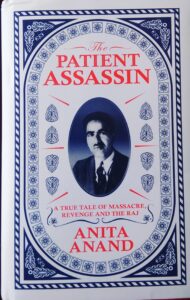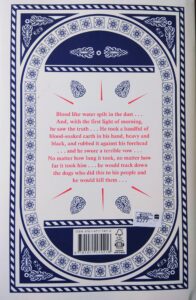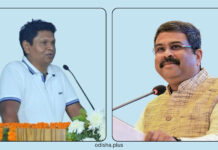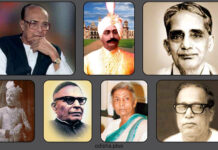Bhaskar Parichha

One of the most horrifying incidents in India’s freedom movement, the Jallianwala Bagh massacre is a black spot of the British rule in India. The crime was committed by General Dyer who ordered Indian soldiers to fire on a peaceful, unarmed, crowd which had gathered celebrate Baisakhi, the Sikh New Year. The congregation was also to protest against the draconian laws imposed by the British which denied an Irish-style home rule.
History has it that, that when Mahatma Gandhi visited Punjab in the aftermath of the carnage, it changed him from a supporter to a staunch opponent of the British rule.Even hundred years after the incident, Jallianwala Bagh has remained controversial particularly when it came to admission of guilt.

Although a number of books have been written on the occasion of the centenary of the Jallianwala Bagh incident, ‘The Patient Assassin’ by Anita Anand stands out prominently for its approach and style. When a crime thriller doubles up as a historical study, it has got to be an amazing work.
‘The Patient Assassin – A True story Of Massacre, Revenge and The Raj ’ is a true account of Udham Singh, the revolutionary who killed Sir Michael O’Dwyer in a crowded London town hall in March 1940 –twenty years after the reprehensible occurrence .According to the author,Udham Singh spent years fixated with revenge. He stalked O’Dwyer and ultimately shot him on the snowy day in Caxton Hall. Three months later Udham Singh was hanged after a deceptive trial.
As the blurb says, ‘the dramatic true story of a celebrated young survivor of a 1919 British massacre in India, and his ferocious twenty-year campaign of revenge that made him a hero to hundreds of millions—and spawned a classic legend.’
Anand’s describes Udham Singh as “a real-life Tom Ripley”. Part of the Ghadar Movement – where Bhagat Singh and Madan Lal Dhingra grew up as revolutionaries -, Singh was a low-caste, barely literate Sikh. By sheer will, he transformed himself into one of Ghadar’s chief operatives. He would work in Africa, Iraq and the US. He would fraternize with the Bolsheviks, the Germans and anyone with a grouse against the British Empire, before eventually making his way to the UK. He had a number of aliases, including the memorable “Muhammad Singh Azad” at the time of the assassination.
Anand further writes, ‘he was an incorrigible ladies’ man, and, by all accounts, very charismatic. He would marry a Mexican woman, Lupe, and father two children, whom he would ruthlessly abandon in his quest for revenge. He would even work briefly as an “extra” in big movies’. Udham Singh was even used by Nazi leader Joseph Goebbels as propaganda against the British rule in India.

The book – running into more than three hundred pages – opens with a remarkable and brutal scene: Famed hangman Albert Pierrepoint going to Pentonville Prison to assist with the hanging of Singh. Singh had been trying to starve himself to death to escape the noose, making estimating his weight difficult. Pierrepoint would go on to hang more than 400 people. As Anand writes, ‘In death, Udham Singh had inadvertently set Albert Pierrepoint up for life.’
‘my grandfather, Ishwar Das Anand, was in the garden that day in 1919. By a quirk of fate, he left Jallianwala Bagh on an errand minutes before the firing started. He remembered Brigadier General Dyer’s convoy passing him in the street. When he returned, my grandfather found his friends, young men like him in their late teens, had been killed.’
Tracing Udham Singh’s dramatic journey from the east to the west to avenge a grave wrong, Anand writes in this gripping tale, “the moment he pulled the trigger, he became the most hated man in Britain, a hero to his countrymen in India, and a pawn in international politics.
Anand also investigates the backgrounds of Sir Michael O’Dwyer and Reginald Dyer, and what drove them to gun down innocent women and children. While telling the story of Udham Singh, the author goes into the stories of the immigrants from Punjab to the US and the UK giving them a rare personalization and readability.
Fascinatingly, Anand has a strong connection to the massacre. Her grandfather Ishwar Das Anand was at Jallianwala Bagh on 13 April 1919. He narrowly escaped being killed. Writes Anand in her book, ‘my grandfather, Ishwar Das Anand, was in the garden that day in 1919. By a quirk of fate, he left Jallianwala Bagh on an errand minutes before the firing started. He remembered Brigadier General Dyer’s convoy passing him in the street. When he returned, my grandfather found his friends, young men like him in their late teens, had been killed.’
Why is Udham Singh not more widely known? Anand says it is because the British government wanted to distance him as much as possible from the Jallianwala Bagh incident to cover up its own incompetence at a time of war. “Udham was right on their radar for years, and they let him slip through their fingers time and time again,” says Anand.
Many of the classified documents Anand uncovered have only been available to the public from 2016; others were destroyed. Her research shows that both MI5 and the Special Branch tried hard to cover up the “mess that occurred on their watch”.
This book on Jallianwala Bagh and Udham Sigh by Anand – who is a Biographer and BBC host – is a riveting saga of the most awful atrocity in the history of the Raj. If Udham Singh is a brave man for many in Punjab, the book does full justice to the man for whom retribution had no time limit.
A meticulously -researched book with neatly laid out chapters and free flow of words, ‘The Patient Assassin’ is a must-read for history buffs as well as thriller aficionados.
The Patient assassin
By Anita Anand
Simon & Schuster UK Ltd
222, Gray’s Inn Road
London W C IX 8 H B
Rs 599
(The reviewer is a senior journalist and Consulting Editor,OdishaPlus)






















